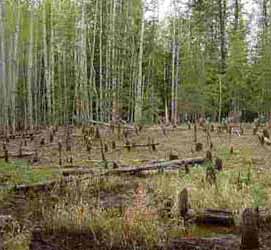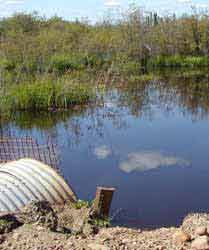 Alberta's WaterIntroductionPublications Climate Change Industrial Impacts Agricultural Impacts Urban Impacts Biodiversity Loss Definitions Links Site Map |
 |
|
 |
 |
 |
| The majority of aspen within 35 metres of the streams were felled by beavers |
Culverts are often plugged by beavers |
A one-year-old beaver stump |
These findings highlight the importance of beavers along streams in northern Alberta. Current logging rules require companies to leave uncut 'buffer strips' along streams to protect aquatic habitats from negative impacts. At the ponds I studied, beavers are removing 90% of trees within 35 m of the water - management planning for aquatic habitats should therefore consider this impact and account for beaver activities.
Comparing road crossings and beaver dams
Throughout the study area, beavers and roads interact: beavers take advantage of road crossings and create ponds by plugging the culverts, instead of building dams (very clever! beavers aren't fools). Due to this interaction, it was impossible to separate the effects of road crossings themselves.
On the whole, road crossings and beaver dams seemed to have similar effects on riparian vegetation, raising water levels upstream. Vegetation zones were much more variable at beaver dams, implying that road crossings may be more permanent sites of flow interruption than beaver dams.
Acknowledgements
This project received funding and logistic support from Alberta Pacific Forestry Ltd., the Sustainable Forest Management Network, and the Adaptive Management Experiment Team. Thanks also to Scott Boorman, Kristen Ostermann, Carla Mellott, and Kaia the Dogg for help and fun in the field, and to NSERC, Ralph Steinhauer Award, Alberta Ingenuity, Walter H. Johns scholarship and the Department of Renewable Resources for financial support.



 Patterns of Riparian Disturbance in Alberta's Boreal
Patterns of Riparian Disturbance in Alberta's Boreal